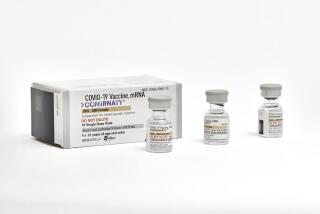With genetic engineering, scientists use decoy molecule to trick HIV
An effective vaccine for HIV has eluded researchers for several decades, due to the pathogen’s infamous shape-shifting abilities.
Even though researchers have identified certain broadly neutralizing antibodies that can conquer multiple strains of the human immunodeficiency virus, many strains of rapidly mutating HIV remain resistant to the these super antibodies.
In recent years however, researches have proposed a new method of battling the virus that involves gene therapy.
Instead of using a vaccine to stimulate the body’s own immune system, so that it produces HIV antibodies, scientists are bypassing the immune system entirely.
In experiments involving rats and monkeys, the researchers have used non-life-threatening viruses to alter the animals’ genome so that its cells produce designer molecules capable of neutralizing HIV.
In a paper published Wednesday in the journal Nature, a team of researchers said they had used the technique to protect rhesus macaques from repeated intravenous injections of a SHIV, a combination of simian immunodeficiency virus and human immunodeficiency virus.
The technique, researchers said, “can function like an effective HIV-1 vaccine.” (HIV-1 is the main family of the virus, and accounts for most infections worldwide.)
When HIV enters the body, it attacks specific immune cells. As the virus copies itself over and over, and kills more and more host cells, the immune system grows progressively weaker. If left untreated, this progressive weakening will give rise to AIDS.
In most cases, the HIV virus begins its attack by latching onto two separate protein structures on the surface of its target white blood cells. One of these structures is called CD4, and the other is called CCR5.
In the Nature study, researchers set out to engineer an antibody-like molecule that would mimic both of these proteins, so that it would act as decoy of sorts for the virus. Instead of latching onto a host cell, HIV would latch onto a specially enhanced protein molecule, or eCD4-Ig, that was released by the cell.
Lead study author Matthew Gardner, an infectious disease researcher at the Scripps Research Institute in Jupiter, Fla., and his colleagues found that the enhanced protein was effective against many strains of HIV.
However, their next challenge was encouraging the cells of test animals to produce the protein on their own.
To do this they turned to an adeno-associated virus, or AAV, which infects humans and other primates, but does not cause illness.
The researchers genetically altered the genome of the virus so that it contained the instructions for the production of the enhanced protein. The viral vectors were then injected into the thighs of four macaques.
Once inside the monkeys, the altered virus integrated with the genome of host cells, giving them them the means to produce the enhanced protein.
To test whether the technique worked, the researchers repeatedly injected SHIV into the four monkeys, along with four other monkeys who had not undergone the gene therapy treatment.
After 34 weeks, none of the gene therapy macaques were infected with SHIV, whereas all of the monkeys that did not undergo the treatment had become infected.
“Although there are remaining challenges, these observations suggest that AAV-expressed eCD4-Ig could provide effective, long-term and near universal protection from HIV-1,” the authors concluded.
It could be quite some time before the technique is shown to work in humans.
In an accompanying News and Views article, HIV researcher Nancy Haigwood of the Oregon National Primate Research Center, Oregon Health & Science University, noted that the sample size of the monkey experiments was “quite small.”
“Larger experiments in non-human primates are warranted,” she wrote.
Such research should examine the technique’s effectiveness in other more traditional routes of infection, such as through mucous membranes.
“Another major question rests in understanding the safety of eCD4-Ig in humans,” Haigwood wrote.
That question could be answered only through “careful and stepwise clinical safety testing,” she said.
Follow @montemorin for science news







